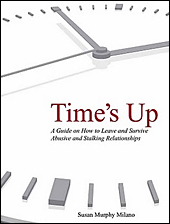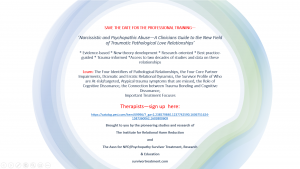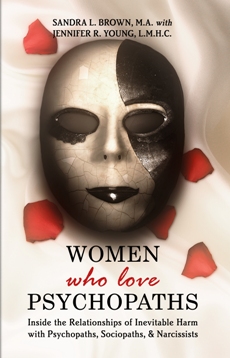Just as not all victims are the same, not all perpetrators of harm are the same either. There is a temptation to ‘lump’ them all together–making ‘who’ they are that makes them abuse others the same as other abusers and what they ‘do’ as abusers the same as other abusers. Perhaps this is where Domestic Violence theory and Pathology theory walk different paths.
Pathology is often the missing piece when looking at the domestic violence or abuse scenario. Pathologicals are part of the continuum of abuse–but usually hover at the upper end of the continuum. They represent those who relapse into abusive behavior (emotional, physical, sexual, spiritual, and/or financial) no matter how many batterer intervention groups they are forced into. Their biology and hard wiring is often overlooked by the court system that mandates these groups and over looked by the organizations who offer batterer programs. But it is exactly their pathology that distinguishes them from other abusers.
I have suggested repeatedly that those who run Batterer Intervention Programs need to personality-disorder test those who entering anger management, batterer groups, and other similar programs. That’s because we need to weed out those who will not only not be helped by the program, but as Robert Hare says, will only learn how to use the information in the groups against the victims, the system, and other organizations running similar programs. There’s also no use in wasting taxpayers money on treatment for those who don’t benefit from treatment.
Pathologicals (those with the ‘Dangerous and Severe Personality Disorders of Cluster B/Psychopathy) are those most likely to abuse the group by gathering info and becoming a slyer abuser. They are the ones most likely to use the information they learned in group later on the judge, their attorney, court evaluators, child evaluators, etc. If Hare didn’t think pathologicals should be given treatment in prison, why do we think they should be given similar treatment information outside of prison like groups that end up being ‘pre-prison’ routes for many pathologicals?
Pathologicals are also those most likely to get sent to intervention groups over and over again. There is a danger in ‘graduating’ the pathologicals for having ‘successfully’ completed their weeks in batterer intervention and/or anger management. They return to the victim with a certificate in hand by an organization that says ‘They have completed the program’ when what really occurred was that they did not benefit in a long-term way from what they were taught. But the certificate helps the abuser get in the door again.
Many victims think they are protecting themselves by mandating the abuser has to go through intervention to be able to come home again. It’s a mirage that we offer when we give a pathological a certificate of completion. Batterer groups and court ordered anger management need to be offered for those who can truly ‘complete’ the program because they have the capacity to sustain the positive change that the program says they need to change. I have known many a case in which the victim was killed after the batterer intervention program when they let the new ‘graduate’ back into their home.
Pathologicals are those most likely to convince others that they are not the problem–that she is, or the world, their job, their childhoods, their attorneys, etc.
Pathologicals are those most likely to stalk. They don’t take no or go away as answers–they take it as a challenge. When programs like DV are helping women with stalking, they need to understand that by nature of what causes most stalkers to behave the way they do they are either personality disorders/pathology or they are chronically mentally ill as in schizophrenia and often unmedicated bipolars. Your run-of-the-mill unhappy husband who has been dumped doesn’t stalk.
Pathologicals are those most likely to abandon children and bolt. Giving partial custody or unsupervised visitation is to invite the natural outcomes of a pathological with poor impulse control.
Pathologicals are those most likely to expose children to abuse, neglect, and their pathological lifestyles. They are those most likely to program children against the protective and non-pathological parent.
And last but certainly not least, pathologicals are those most likely to kill or attempt to kill. Without conscience, empathy, guilt, remorse or insight—someone so ‘inconvenient’ like an ‘abuse tattler’ is likely to be seen as a swarming gnat and killed with the same amount of forethought.
Clearly, not all abusers are pathological. I have seen many people go through batterer intervention and ‘get it,’ go home, change their behaviors, positively impact their marriages and families and never do it again. But in pathology, there’s ‘nothing wrong with them’ so why change? In pathology, it’s always someone else’s problem–it’s never about their behavior. In pathology, it’s not merely about the Power & Control Wheel that explains their abuse of power. In narcissism and psychopathy, power is food. It’s not ‘a way of looking at relationship dynamics’ — it just ‘is.’ It is biological not dynamic. The new information out on the neuroscience of chronic batterers and other pathological types show us the parts of the brain that are impacted and prevent them from change. This is not merely willful behavior, this is his hard wiring.
All abuse is an abuse of power. But not all abuse of power is treatable or curable. It is not that there aren’t similarities in the abuse or even the abuser–but in pathology the abuse of power has no cure. Abuses, addiction, mental health issues all have the hope of treatment when there is insight and the ability to sustain change. But in pathology, the inability to grow, sustain consistent positive change, or develop insight about how their behavior negatively affects others precludes them from the benefit of treatment.
That IS what pathology is–the inability to be helped by medication, counseling, spiritually, or even love. Abusers who are not pathological have the ability to grow, change, and develop insight about how their abuse of power and control harms others. Pathologicals can never do that.
That is why all abusers are not created equal.













